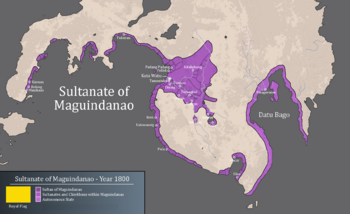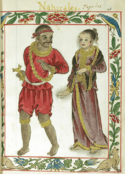Sultanate of Maguindanao facts for kids
Quick facts for kids
Sultanate of Maguindanao
كاسولتانن نو ماڬينداناو
(Old Maguindanaon) Kasultanan nu Magindanaw |
|||||||||||
|---|---|---|---|---|---|---|---|---|---|---|---|
| 1520–1928 | |||||||||||
|
Flag
|
|||||||||||

Detailed map of the maximum extent of the territory of the Sultanate of Maguindanao in 1800 (purple) and its subjects (light purple) according to various accounts.
|
|||||||||||
| Capital | Kuta Watu, Malabang | ||||||||||
| Common languages | Maguindanaon, Arabic, Malay, Maranao, Kalagan, Iranun, Manobo languages | ||||||||||
| Religion | Islam | ||||||||||
| Government | Absolute monarchy | ||||||||||
| Sultan | |||||||||||
|
• 1520–1543
|
Sharif Kabungsuwan | ||||||||||
|
• 1597–1619
|
Kapitan Laut Buisan | ||||||||||
|
• 1619–1671
|
Sultan Dipatuan Qudarat I | ||||||||||
| Historical era | Spanish colonial era | ||||||||||
|
• Established by Sharif Kabungsuwan
|
1520 | ||||||||||
|
• Assassination of Datu Ali
|
1928 | ||||||||||
| Currency | Barter | ||||||||||
|
|||||||||||
| Today part of | Philippines | ||||||||||
| Pre-colonial history of the Philippines |
| Barangay government |
| Ruling class (Maginoo, Tumao): Apo, Datu, Lakan, Panglima, Rajah, Sultan, Thimuay |
| Middle class: Timawa, Maharlika |
| Serfs, commoners and slaves (Alipin): Aliping namamahay, Alipin sa gigilid, Bulisik, Bulislis, Horohan, Uripon |
| States in Luzon |
| Caboloan |
| Cainta |
| Ibalon |
| Ma-i |
| Rajahnate of Maynila |
| Namayan |
| Tondo |
| States in the Visayas |
| Kedatuan of Madja-as |
| Kedatuan of Dapitan |
| Rajahnate of Cebu |
| States in Mindanao |
| Rajahnate of Butuan |
| Rajahnate of Sanmalan |
| Sultanate of Sulu |
| Sultanate of Maguindanao |
| Sultanates of Lanao |
| Key figures |
|
| The book of Maragtas |
| Religion in pre-colonial Philippines |
| History of the Philippines |
| Portal: Philippines |
The Sultanate of Maguindanao was a powerful kingdom in the southern Philippines. It ruled over parts of the island of Mindanao. This included areas like modern-day Maguindanao provinces, Soccsksargen, Zamboanga Peninsula, and Davao Region. The Sultanate was important during the time of European colonization. It had friendly relationships with British and Dutch traders.
Contents
History of the Sultanate
Before the Sultanate of Maguindanao was formed, there was a state called Wenduling. This state was invaded by Brunei. Later, it rebelled against Brunei.
Islam then came to the area. Two brothers, Mamalu and Tabunaway, lived peacefully in the Cotabato Valley. Then, in the 16th century, Shariff Mohammed Kabungsuwan arrived from Johor, Malaysia. He taught people about Islam. Tabunaway decided to become Muslim. Mamalu chose to keep his old beliefs, which were about nature spirits. The brothers went their separate ways. Tabunaway stayed in the lowlands, and Mamalu went to the mountains. But they promised to always be friends. This created a lasting peace between the Maguindanaons and the local people.
Shariff Kabungsuwan introduced Islam to the area. Before this, the region was influenced by Hindu beliefs. He became the first Sultan of Maguindanao. His main city was in Malabang-Lanao. He married into local leader families. This helped him set up the Sultanate. The main center of the Sultanate was usually in the Cotabato Valley.
Sultan Kudarat was one of the most important sultans. He was known for controlling much of Mindanao. He was also called Ullah Untong when he was young. Kudarat was buried in Sulu after his rule. His grandson, Abd al-Rahman, helped the Sultanate grow even stronger.
The Maguindanao Sultanate also had a strong friendship with the Sultanate of Ternate. Ternate was a kingdom in Indonesia. Ternate often sent soldiers to help Maguindanao. This happened during the Spanish-Moro Wars.
However, the Sultanate's power became smaller over time. The Confederate States of Lanao decided to become independent from Maguindanao.
During the time of Spanish rule, the Sultanate of Maguindanao protected its lands well. They stopped the Spanish from taking over all of Mindanao. In 1705, they gave the island of Palawan to the Spanish. This was done to help keep the Spanish away from Maguindanao and Sulu.
Chinese culture also influenced Mindanao. Yellow, a royal color, and Chinese gongs became part of the culture. Chinese traders lived peacefully with the people of Maguindanao.
Leaders of Maguindanao
Historical records show that there were 24 Sultans of Maguindanao. Here are some of the most important ones:
| Reign | Name | Capital |
|---|---|---|
| 1520-1543 | Sharif Ali Kabungsuwan | Malabang |
| 1543-1574 | Sharif Makaalang | |
| 1574-1578 | Datu Bangkaya | |
| 1578-1585 | Datu Dimasangkay | |
| 1585-1597 | Datu Salikula | |
| 1597-1619 | Kapitan Laut Buisan | |
| 1619-1671 | Sultan Kudarat | Lamitan, Simuay |
| 1671-1675 | Sultan Dundang Tidulay | Simuay |
| 1675-1699 | Sultan Barahaman | Simuay |
| 1699-1702 | Sultan Kahar Ud-din Kuda | Simuay |
| 1702-1736 | Sultan Bayan Ul-Anwar | Slangan |
| 1710-1733 | Sultan Muhammad Ja’far Sadiq Manamir | Tamontaka |
| 1736-1748 | Sultan Muhammad Tahir Ud-din | Tamontaka |
| 1733-1755 | Sultan Muhammad Khair Ud-din | |
| 1755-1780 | Sultan Pahar Ud-din | |
| 1780-1805 | Sultan Kibad Sahriyal | |
| 1805-1830 | Sultan Kawasa Anwar Ud-din | |
| 1830-1854 | Sultan Iskandar Qudrallah Muhammad Zamal Ul-Azam | |
| 1854-1884 | Sultan Muhammad Makakwa | |
| 1884-1888 | Sultan Mohammad Jalal Ud-din Pablu | Banubu |
| 1896-1926 | Sultan Mangigin | Cotabato, Sibugay |
| 1926-1938 | Sultan Muhammad Hijaban Iskandar Mastura Kudarat | |
| 1938-1991 | Sultan Tato Esmael | |
| 1991-2000 | Sultan Muhammad Baraguir | |
| 2000-2006 | Sultan Sayyid Amir Baraguir | |
| 2006-present | Sultan Al Borot |
Sharif Muhammad Kabungsuwan
Sharif Ali Kabungsuwan was a prince from Johore, Malaysia. He arrived in Mindanao around 1515. He met the brothers Tabunaway and Mamalu. He taught Islam to many people. Kabungsuwan married into local royal families. He then founded the Sultanate of Maguindanao. He became its first Sultan, known as Sultan Aliwya.
Sultan Kudarat
Sultan Kudarat was a son of Buisan. He was a very strong leader. He united different groups in the area. He made Simuay a free trading port. He ruled for about 50 years, from 1619 to 1671. By 1645, he was using the title "sultan." He was known for defending his people against the Spanish.
Family Tree of Maguindanao Sultans
| Family tree of Maguindanao monarchs | |||||||||||||||||||||||||||||||||||||||||||||||||||||||||||||||||||||||||||||||||||||||||||||||||||||||||||||||||||||||||||||||||||||||||||||||||||||||||||||||||||||||||||||||||||||||||||||||||||||||||||||||||||||||||||||||||||||||||||||||||||||||||||||||||||||||||||||||||||||||||||||||||||||||||||||||||||||||||||||||||||||||||||||||||||||||||||||||||||||||||||||||||||||||||||||||||||||||||||||||||||||||||||||||||||||||||||||||||||||||||||||||||||||||||||||||||||||||||||||||||||||||||||||||||||||||||||||||||||||||||||||||||||||||||||||||||||||||||||||||||||||||||||||||||||||||||||||||||||||||||||||||||||||||||||||||||||||||||||||||||||||||||||||||||||||||||||||||||||||||||||||||||||||||||||||||||||||||||||||||||||||||||||||||||||||||||||||||||||||||||||||||||||||||||||||||||||||||||||||||||||||||||||||||||||||||||||||||||||||||||||||||||||||||||||||||||||||||||||||||||||||||||||||||||||||||||||||||||||||||||||||||||||||||||||||||||||||||||||||||||||||||||||||||||||||||||||||||||||||||
|---|---|---|---|---|---|---|---|---|---|---|---|---|---|---|---|---|---|---|---|---|---|---|---|---|---|---|---|---|---|---|---|---|---|---|---|---|---|---|---|---|---|---|---|---|---|---|---|---|---|---|---|---|---|---|---|---|---|---|---|---|---|---|---|---|---|---|---|---|---|---|---|---|---|---|---|---|---|---|---|---|---|---|---|---|---|---|---|---|---|---|---|---|---|---|---|---|---|---|---|---|---|---|---|---|---|---|---|---|---|---|---|---|---|---|---|---|---|---|---|---|---|---|---|---|---|---|---|---|---|---|---|---|---|---|---|---|---|---|---|---|---|---|---|---|---|---|---|---|---|---|---|---|---|---|---|---|---|---|---|---|---|---|---|---|---|---|---|---|---|---|---|---|---|---|---|---|---|---|---|---|---|---|---|---|---|---|---|---|---|---|---|---|---|---|---|---|---|---|---|---|---|---|---|---|---|---|---|---|---|---|---|---|---|---|---|---|---|---|---|---|---|---|---|---|---|---|---|---|---|---|---|---|---|---|---|---|---|---|---|---|---|---|---|---|---|---|---|---|---|---|---|---|---|---|---|---|---|---|---|---|---|---|---|---|---|---|---|---|---|---|---|---|---|---|---|---|---|---|---|---|---|---|---|---|---|---|---|---|---|---|---|---|---|---|---|---|---|---|---|---|---|---|---|---|---|---|---|---|---|---|---|---|---|---|---|---|---|---|---|---|---|---|---|---|---|---|---|---|---|---|---|---|---|---|---|---|---|---|---|---|---|---|---|---|---|---|---|---|---|---|---|---|---|---|---|---|---|---|---|---|---|---|---|---|---|---|---|---|---|---|---|---|---|---|---|---|---|---|---|---|---|---|---|---|---|---|---|---|---|---|---|---|---|---|---|---|---|---|---|---|---|---|---|---|---|---|---|---|---|---|---|---|---|---|---|---|---|---|---|---|---|---|---|---|---|---|---|---|---|---|---|---|---|---|---|---|---|---|---|---|---|---|---|---|---|---|---|---|---|---|---|---|---|---|---|---|---|---|---|---|---|---|---|---|---|---|---|---|---|---|---|---|---|---|---|---|---|---|---|---|---|---|---|---|---|---|---|---|---|---|---|---|---|---|---|---|---|---|---|---|---|---|---|---|---|---|---|---|---|---|---|---|---|---|---|---|---|---|---|---|---|---|---|---|---|---|---|---|---|---|---|---|---|---|---|---|---|---|---|---|---|---|---|---|---|---|---|---|---|---|---|---|---|---|---|---|---|---|---|---|---|---|---|---|---|---|---|---|---|---|---|---|---|---|---|---|---|---|---|---|---|---|---|---|---|---|---|---|---|---|---|---|---|---|---|---|---|---|---|---|---|---|---|---|---|---|---|---|---|---|---|---|---|---|---|---|---|---|---|---|---|---|---|---|---|---|---|---|---|---|---|---|---|---|---|---|---|---|---|---|---|---|---|---|---|---|---|---|---|---|---|---|---|---|---|---|---|---|---|---|---|---|---|---|---|---|---|---|---|---|---|---|---|---|---|---|---|---|---|---|---|---|---|---|---|---|---|---|---|---|---|---|---|---|---|---|---|---|---|---|---|---|---|---|---|---|---|---|---|---|---|---|---|---|---|---|---|---|---|---|---|---|---|---|---|---|---|---|---|---|---|---|---|---|---|---|---|---|---|---|---|---|---|---|---|---|---|---|---|---|---|---|---|---|---|---|---|---|---|---|---|---|---|---|---|---|---|---|---|---|---|---|---|---|---|---|---|---|---|---|---|---|---|---|---|---|---|---|---|---|---|---|---|---|---|---|---|---|---|---|---|---|---|---|---|---|---|---|---|---|---|---|---|---|---|---|---|---|---|---|---|---|---|---|---|---|---|---|---|---|---|---|---|---|---|---|---|---|---|---|---|---|---|---|---|---|---|---|---|---|---|---|---|---|---|---|---|---|---|---|---|---|---|---|---|---|---|---|---|---|---|---|---|---|---|---|---|---|---|---|---|---|---|---|---|---|---|---|---|---|---|---|---|---|---|---|---|---|---|---|---|---|---|---|---|---|---|---|---|---|---|---|---|---|---|---|---|---|---|---|---|---|---|---|---|---|---|---|---|---|---|---|---|---|---|---|---|---|---|---|---|---|---|---|---|---|---|---|---|---|---|---|---|---|---|---|---|---|---|---|---|---|---|---|---|---|---|---|---|---|---|---|---|---|---|---|---|---|---|---|---|---|---|---|---|---|---|---|---|---|---|---|---|---|---|---|---|---|---|
|
|||||||||||||||||||||||||||||||||||||||||||||||||||||||||||||||||||||||||||||||||||||||||||||||||||||||||||||||||||||||||||||||||||||||||||||||||||||||||||||||||||||||||||||||||||||||||||||||||||||||||||||||||||||||||||||||||||||||||||||||||||||||||||||||||||||||||||||||||||||||||||||||||||||||||||||||||||||||||||||||||||||||||||||||||||||||||||||||||||||||||||||||||||||||||||||||||||||||||||||||||||||||||||||||||||||||||||||||||||||||||||||||||||||||||||||||||||||||||||||||||||||||||||||||||||||||||||||||||||||||||||||||||||||||||||||||||||||||||||||||||||||||||||||||||||||||||||||||||||||||||||||||||||||||||||||||||||||||||||||||||||||||||||||||||||||||||||||||||||||||||||||||||||||||||||||||||||||||||||||||||||||||||||||||||||||||||||||||||||||||||||||||||||||||||||||||||||||||||||||||||||||||||||||||||||||||||||||||||||||||||||||||||||||||||||||||||||||||||||||||||||||||||||||||||||||||||||||||||||||||||||||||||||||||||||||||||||||||||||||||||||||||||||||||||||||||||||||||||||||||
Images for kids
See also
 In Spanish: Sultanato de Maguindánao para niños
In Spanish: Sultanato de Maguindánao para niños
- List of Sunni Muslim dynasties
- Johor Sultanate
- Sultanate of Sulu




